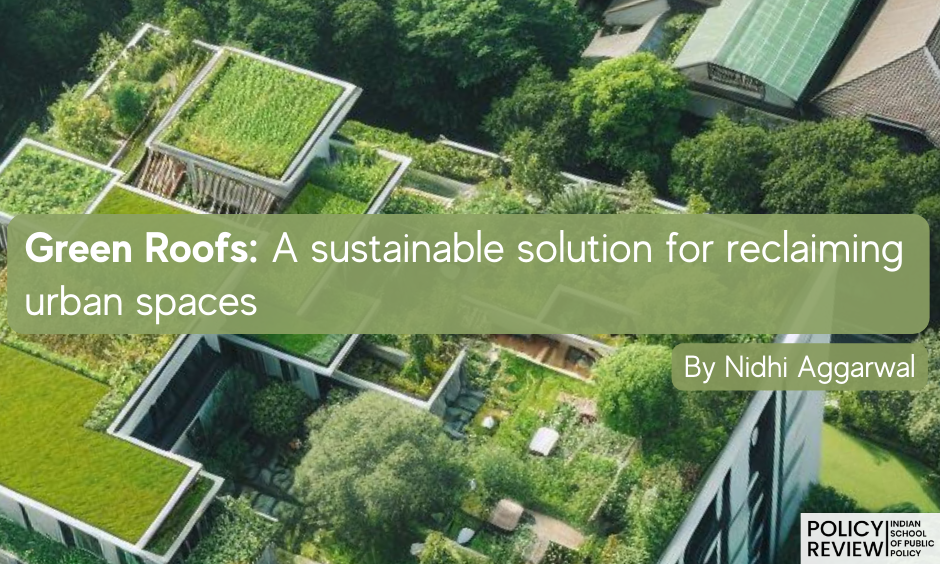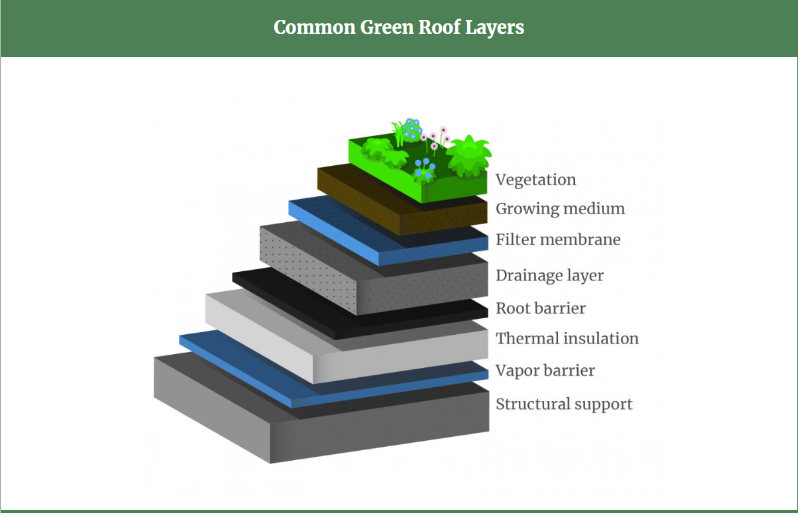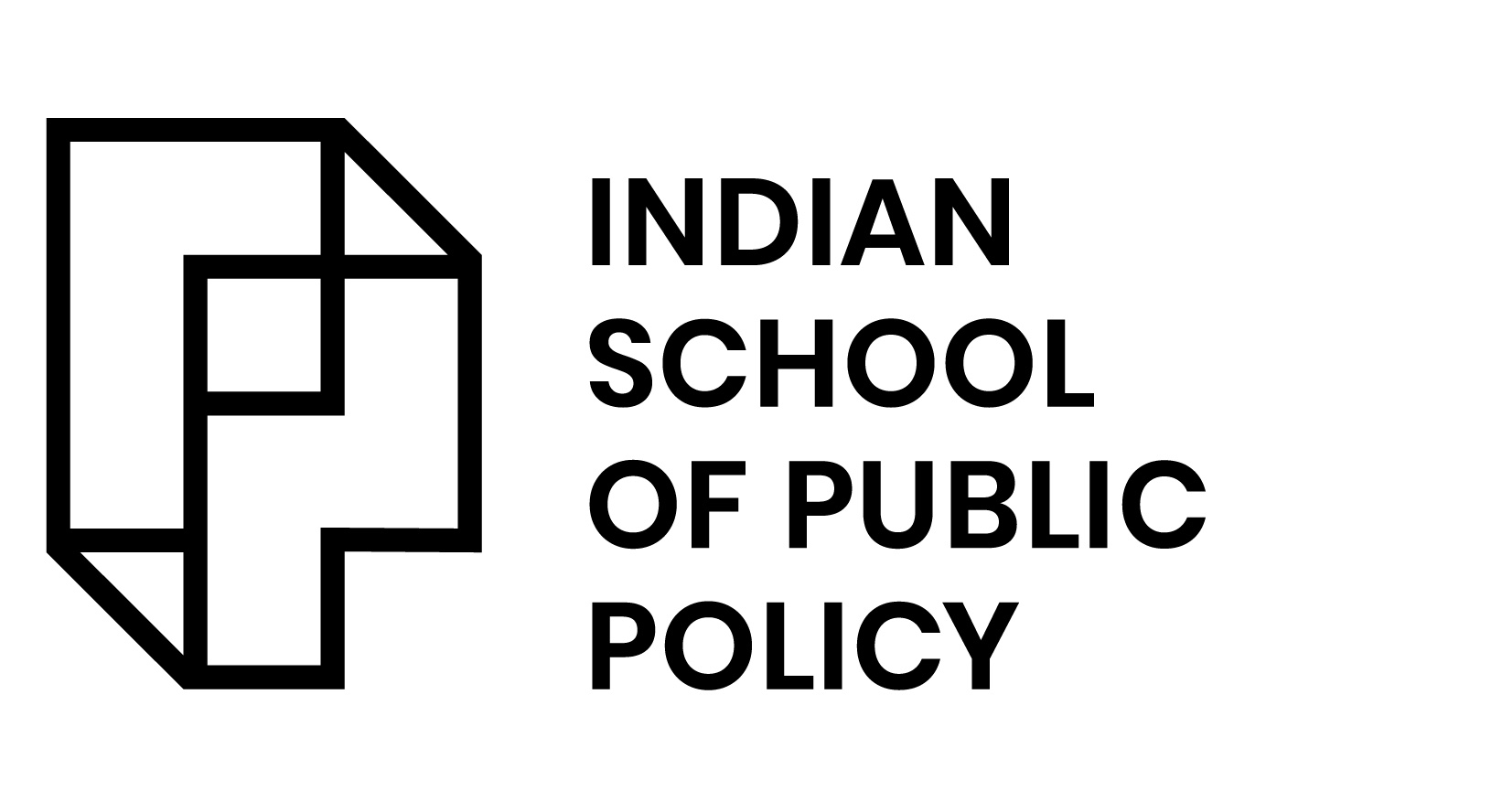
Green roofs: A sustainable solution for reclaiming urban spaces

Urban areas are increasingly defined by concrete jungles, pollution, flash floods, and heat islands. In fact, NITI Aayog estimates that nearly 65% of India’s energy is consumed for space cooling and heating, with this demand set to rise eleven-fold by 2037-38 (Michael & Gautam, 2023). As cities grapple with these challenges, a sustainable solution emerges: the widespread adoption of green roofs. These eco-friendly innovations can play a key role in reclaiming urban spaces and addressing the environmental and energy concerns faced by cities today.
In this blog, we will understand the importance of green roofs in addressing these issues, the benefits they offer, and how they can be integrated into urban planning to create healthier, more sustainable cities.
What are green roofs?
Green roofs, also known as living roofs, are rooftops covered with vegetation, which are installed over the standard structural framework and waterproofing elements of a conventional roof. These roofs are designed to mimic natural ecosystems by incorporating layers of vegetation, structural support, waterproofing, root barriers, insulation, and water management systems. By doing so, green roofs help regulate temperature, absorb pollutants, and provide numerous environmental benefits.

The need for green roofs in urban areas
Urban areas face a host of environmental and spatial challenges that compromise the quality of life for residents. From combating the lack of green spaces to addressing climate-related issues, green roofs present a sustainable solution to rejuvenate urban landscapes. Below are some critical areas where green roofs can make a transformative impact.
Overcoming space challenges
One of the biggest challenges facing urban areas today is the lack of green spaces. With rapid urbanization, open spaces are becoming increasingly scarce, leading to higher pollution levels and a decline in the overall quality of life. Green roofs offer a viable solution to this issue by utilizing the rooftops of buildings, which are often underused. They can be installed on a wide range of structures, including residential homes, government offices, and private buildings, as well as public spaces like bus shelters.
Addressing the urban heat island effect
Urban areas often experience higher temperatures than surrounding rural areas, a phenomenon known as the “urban heat island effect.” The prevalence of concrete, asphalt, and other heat-absorbing materials exacerbates this problem. Green roofs can help mitigate this effect by providing insulation and reducing the amount of heat absorbed by buildings. According to the US Environmental Protection Agency (EPA), green roofs can lower ambient city temperatures by up to 5°F, and conventional roofs can see a temperature reduction of 30 to 40 degrees Fahrenheit.
Improving air quality and health
The integration of green roofs into urban spaces also has significant health benefits. Urban greenery improves air quality by filtering pollutants and capturing harmful gases. Modelling studies (University of Surrey) have shown that green roofs can reduce air pollution by 30 to 57 percent, contributing to cleaner air and healthier urban environments. Additionally, green spaces have been linked to stress reduction, increased physical activity, and better mental well-being. The presence of green roofs improves not only the aesthetics of a city but also the overall quality of life for its residents.
Green roofs do more than just enhance the visual appeal of cities; they lay the groundwork for sustainable urban living by addressing critical environmental concerns.
Environmental benefits of green roofs
Green roofs are not only practical but also a critical part of addressing environmental challenges in cities. They provide the following solutions, each contributing to a healthier urban ecosystem.
Stormwater management and groundwater recharge
According to studies, green roofs play a crucial role in managing stormwater runoff, which is a major challenge in many urban areas. These roofs are designed to retain significant amounts of precipitation, reducing surface runoff and preventing flash floods. In summer, green roofs can retain up to 70 to 90% of the rainwater that falls on them, and in winter, this retention rate is still high, ranging from 25 to 40%. This captured rainwater can be directed into rainwater harvesting systems, which helps recharge groundwater supplies and conserve water resources. Furthermore, the water that passes through green roofs is naturally filtered, contributing to water quality improvement. This is how the green roofs help in the conservation and recycling of water.
Reducing energy consumption
By insulating buildings and reducing the heat absorbed by urban surfaces, green roofs also contribute to energy savings. Studies indicate that green roofs can reduce energy usage in buildings by approximately 0.7% compared to conventional roofing systems. This reduction in energy demand not only lowers electricity costs but also contributes to a decrease in greenhouse gas emissions, which helps combat global warming.
These environmental benefits highlight the importance of green roofs in creating energy-efficient, sustainable cities while addressing pressing climate challenges.
Economic and social impact of green roofs
Green roofs go beyond environmental solutions, offering tangible economic gains and meaningful social contributions to urban communities. Explore their full potential below.
Job creation
The widespread adoption of green roofs presents numerous economic opportunities. The design, installation, and maintenance of green roofs create jobs in various sectors, including manufacturing, gardening, design, installation, and maintenance services. The green roofing industry has the potential to stimulate economic growth while simultaneously addressing urban environmental issues.
Promoting biodiversity
In addition to their environmental and economic benefits, green roofs can significantly enhance biodiversity in urban areas. By providing habitats for plants, insects, and small animals, green roofs help support ecosystems that are disappearing from urban environments. Species such as bees, butterflies, and birds benefit from the greenery provided by these rooftops, contributing to the overall biodiversity of cities.
By bringing together economic growth, ecological conservation, and social well-being, green roofs set the stage for thriving urban communities.
Challenges in adopting green roofs
Despite their numerous advantages, the adoption of green roofs has been slow, especially in developing countries like India. Several challenges hinder the widespread implementation of these systems:
- High Initial Costs: The construction of green roofs involves significant upfront investment, which can be a barrier for many property owners and developers.
- Maintenance and Renovation Costs: Green roofs require regular maintenance to ensure their longevity and effectiveness, which can incur additional costs.
- Risk of Roof Leakages: Poor design or improper installation can result in water infiltration, causing damage and further deterring adoption.
- Structural Support: Green roofs are heavier than traditional roofs and require additional structural support to bear the weight of the plants, soil, and water retention systems.
However, many of these challenges can be overcome through government policy, incentives, and technological advancements that reduce costs and improve the feasibility of green roofs.
Addressing challenges through policy support
Green roofs are gaining global recognition as a critical component of sustainable urban development. With strong policy backing, these green initiatives can transform urban environments into more livable and eco-friendly spaces.
The global success of policy support
Basel, Switzerland, successfully implemented green roofs with the 2002 amendment to the City of Basel Building and Construction law, mandating green roofs on all new flat roofs. This has resulted in the city having the largest green roof area per capita in the world.
Other regions, such as Singapore, China, and the USA, are following Europe’s example, reaping significant environmental, economic, and health benefits (Versini et al., 2020).
Policy recommendations for India
1. Integrating green roofs into national policies
Green roofs should be included in urban planning initiatives like Pradhan Mantri Awas Yojana and Smart Cities Mission. Their integration can help reduce urban energy requirements and support India’s Cooling Action Plan to reduce heat and energy consumption.
2. Contributing to India’s net-zero emissions goal
Green roofs can assist India in meeting its goal of achieving net-zero emissions by 2070 by reducing greenhouse gases and air pollution.
By addressing the challenges with proper policy frameworks and support, green roofs can provide cities with long-term environmental, economic, and health benefits similar to those experienced in European cities.
Contributing to India’s net-zero emissions goal
The adoption of green roofs can help India fast-track its goal of achieving net-zero emissions by 2070. By reducing greenhouse gas emissions, conserving water, and improving air quality, green roofs align with India’s broader environmental and sustainability targets.
Conclusion: The future of green roofs in urban India
Green roofs offer a sustainable and innovative solution to many of the pressing environmental challenges faced by urban areas. They provide a multitude of benefits, including improved air quality, reduced energy consumption, better stormwater management, and enhanced biodiversity. The adoption of green roofs is essential for creating greener, healthier, and more livable cities.
India can move towards a greener future by adding green roofs to city planning. As cities grow and get busier, green roofs give us a chance to make our urban areas better. They help the environment while also making spaces more lively and tough against challenges.
India could really gain a lot by combining nature and technology. This would create cleaner, healthier cities. Let’s aim to make this “Azadi ka Amritkaal” a “Harit Shehar kaal” by working together towards a sustainable future.
Key Takeaways:
- Green roofs help mitigate urban heat islands, improve air quality, and manage stormwater.
- They offer significant environmental, economic, and health benefits for cities.
- Governments should integrate green roofs into urban planning to support sustainable development.
- Green roofs contribute to achieving sustainability goals like net-zero emissions and water conservation.
References:
- Deshpande, T. (2023, June 30). Explained: As Indoor Heat Rises, Can India Turn To Green Roofs? https://www.indiaspend.com/explainers/explained-as-indoor-heat-rises-can-india-turn-to-green-roofs-867308
- Giannopoulou, M., Roukouni, A., & Lykostratis, K. (2019). Exploring the benefits of urban green roofs: A GIS approach applied to a Greek city.
- Michael, J., & Gautam, S. (2023, September 2). DTE Call For Action: Can India achieve ‘sustainable cooling’? Down to Earth. https://www.downtoearth.org.in/video/energy/dte-call-for-action-can-india-achieve-sustainable-cooling–91516
- Matos Silva, C., Bernardo, F., Manso, M., & Loupa Ramos, I. (2023). Green Spaces over a Roof or on the Ground, Does It Matter? The Perception of Ecosystem Services and Potential Restorative Effects. Sustainability, 15(6), 5334. https://doi.org/10.3390/su15065334
- Shafique, M., Kim, R., & Kyung-Ho, K. (2018). Green Roof for Stormwater Management in a Highly Urbanized Area: The Case of Seoul, Korea. Sustainability, 10(3), 584. https://doi.org/10.3390/su10030584
- Tomson, M., Kumar, P., Barwise, Y., Perez, P., Forehead, H., French, K., Morawska, L., & Watts, J. F. (2021). Green infrastructure for air quality improvement in street canyons. Environment International, 146, 106288. https://doi.org/10.1016/j.envint.2020.106288
- US EPA, O. (2014, June 17). Using Green Roofs to Reduce Heat Islands [Overviews and Factsheets]. https://www.epa.gov/heatislands/using-green-roofs-reduce-heat-islands
- Williams, K. J. H., Lee, K. E., Sargent, L., Johnson, K. A., Rayner, J., Farrell, C., Miller, R. E., & Williams, N. S. G. (2019). Appraising the psychological benefits of green roofs for city residents and workers. Urban Forestry & Urban Greening, 44, 126399. https://doi.org/10.1016/j.ufug.2019.126399
- Versini, P.-A., Gires, A., Tchiguirinskaia, I., & Schertzer, D. (2020). Fractal analysis of green roof spatial implementation in European cities. Urban Forestry & Urban Greening, 49, 126629. https://doi.org/10.1016/j.ufug.2020.126629

Nidhi Aggarwal
PDM Scholar, Class of 2024,
Nidhi Aggarwal is a policy analyst exploring the role of technology and innovative solutions for sustainable development. With experience in research, writing, and community work, she analyses governance through an interdisciplinary lens. Nidhi is currently pursuing her PGP in Public Policy, Design and Management at the Indian School of Public Policy, New Delhi. Her interests include urban issues, climate action, and sustainable development.

